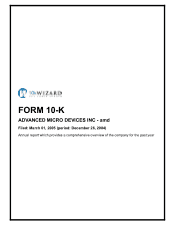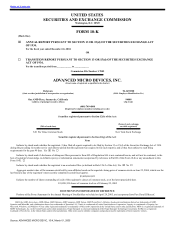AMD 2004 Annual Report Download - page 9
Download and view the complete annual report
Please find page 9 of the 2004 AMD annual report below. You can navigate through the pages in the report by either clicking on the pages listed below, or by using the keyword search tool below to find specific information within the annual report.-
 1
1 -
 2
2 -
 3
3 -
 4
4 -
 5
5 -
 6
6 -
 7
7 -
 8
8 -
 9
9 -
 10
10 -
 11
11 -
 12
12 -
 13
13 -
 14
14 -
 15
15 -
 16
16 -
 17
17 -
 18
18 -
 19
19 -
 20
20 -
 21
21 -
 22
22 -
 23
23 -
 24
24 -
 25
25 -
 26
26 -
 27
27 -
 28
28 -
 29
29 -
 30
30 -
 31
31 -
 32
32 -
 33
33 -
 34
34 -
 35
35 -
 36
36 -
 37
37 -
 38
38 -
 39
39 -
 40
40 -
 41
41 -
 42
42 -
 43
43 -
 44
44 -
 45
45 -
 46
46 -
 47
47 -
 48
48 -
 49
49 -
 50
50 -
 51
51 -
 52
52 -
 53
53 -
 54
54 -
 55
55 -
 56
56 -
 57
57 -
 58
58 -
 59
59 -
 60
60 -
 61
61 -
 62
62 -
 63
63 -
 64
64 -
 65
65 -
 66
66 -
 67
67 -
 68
68 -
 69
69 -
 70
70 -
 71
71 -
 72
72 -
 73
73 -
 74
74 -
 75
75 -
 76
76 -
 77
77 -
 78
78 -
 79
79 -
 80
80 -
 81
81 -
 82
82 -
 83
83 -
 84
84 -
 85
85 -
 86
86 -
 87
87 -
 88
88 -
 89
89 -
 90
90 -
 91
91 -
 92
92 -
 93
93 -
 94
94 -
 95
95 -
 96
96 -
 97
97 -
 98
98 -
 99
99 -
 100
100 -
 101
101 -
 102
102 -
 103
103 -
 104
104 -
 105
105 -
 106
106 -
 107
107 -
 108
108 -
 109
109 -
 110
110 -
 111
111 -
 112
112 -
 113
113 -
 114
114 -
 115
115 -
 116
116 -
 117
117 -
 118
118 -
 119
119 -
 120
120 -
 121
121 -
 122
122 -
 123
123 -
 124
124 -
 125
125 -
 126
126 -
 127
127 -
 128
128 -
 129
129 -
 130
130 -
 131
131 -
 132
132 -
 133
133 -
 134
134 -
 135
135 -
 136
136 -
 137
137 -
 138
138 -
 139
139 -
 140
140 -
 141
141 -
 142
142 -
 143
143 -
 144
144 -
 145
145 -
 146
146 -
 147
147 -
 148
148 -
 149
149 -
 150
150 -
 151
151 -
 152
152 -
 153
153 -
 154
154 -
 155
155 -
 156
156 -
 157
157 -
 158
158 -
 159
159 -
 160
160 -
 161
161 -
 162
162 -
 163
163 -
 164
164 -
 165
165 -
 166
166 -
 167
167 -
 168
168 -
 169
169 -
 170
170 -
 171
171 -
 172
172 -
 173
173 -
 174
174 -
 175
175 -
 176
176 -
 177
177 -
 178
178 -
 179
179 -
 180
180 -
 181
181 -
 182
182 -
 183
183 -
 184
184 -
 185
185 -
 186
186 -
 187
187 -
 188
188 -
 189
189 -
 190
190 -
 191
191 -
 192
192 -
 193
193 -
 194
194 -
 195
195 -
 196
196 -
 197
197 -
 198
198 -
 199
199 -
 200
200 -
 201
201 -
 202
202 -
 203
203 -
 204
204 -
 205
205 -
 206
206 -
 207
207 -
 208
208 -
 209
209 -
 210
210 -
 211
211 -
 212
212 -
 213
213 -
 214
214 -
 215
215 -
 216
216 -
 217
217 -
 218
218 -
 219
219 -
 220
220 -
 221
221 -
 222
222 -
 223
223 -
 224
224 -
 225
225 -
 226
226 -
 227
227 -
 228
228 -
 229
229 -
 230
230 -
 231
231 -
 232
232 -
 233
233 -
 234
234 -
 235
235 -
 236
236 -
 237
237 -
 238
238 -
 239
239 -
 240
240 -
 241
241 -
 242
242 -
 243
243 -
 244
244 -
 245
245 -
 246
246 -
 247
247 -
 248
248 -
 249
249 -
 250
250 -
 251
251 -
 252
252 -
 253
253 -
 254
254 -
 255
255 -
 256
256 -
 257
257 -
 258
258 -
 259
259 -
 260
260 -
 261
261 -
 262
262 -
 263
263 -
 264
264 -
 265
265 -
 266
266 -
 267
267 -
 268
268 -
 269
269 -
 270
270 -
 271
271 -
 272
272 -
 273
273 -
 274
274 -
 275
275 -
 276
276 -
 277
277 -
 278
278 -
 279
279 -
 280
280 -
 281
281 -
 282
282 -
 283
283 -
 284
284 -
 285
285 -
 286
286 -
 287
287 -
 288
288 -
 289
289 -
 290
290 -
 291
291 -
 292
292 -
 293
293 -
 294
294 -
 295
295 -
 296
296 -
 297
297 -
 298
298 -
 299
299 -
 300
300 -
 301
301 -
 302
302 -
 303
303 -
 304
304 -
 305
305 -
 306
306 -
 307
307 -
 308
308 -
 309
309 -
 310
310 -
 311
311 -
 312
312 -
 313
313 -
 314
314 -
 315
315 -
 316
316 -
 317
317 -
 318
318 -
 319
319 -
 320
320 -
 321
321 -
 322
322 -
 323
323 -
 324
324 -
 325
325 -
 326
326 -
 327
327 -
 328
328 -
 329
329 -
 330
330 -
 331
331 -
 332
332 -
 333
333 -
 334
334 -
 335
335 -
 336
336 -
 337
337 -
 338
338 -
 339
339 -
 340
340 -
 341
341 -
 342
342 -
 343
343 -
 344
344 -
 345
345 -
 346
346 -
 347
347 -
 348
348 -
 349
349 -
 350
350 -
 351
351 -
 352
352 -
 353
353 -
 354
354 -
 355
355 -
 356
356 -
 357
357 -
 358
358 -
 359
359 -
 360
360 -
 361
361 -
 362
362 -
 363
363 -
 364
364 -
 365
365 -
 366
366 -
 367
367 -
 368
368 -
 369
369 -
 370
370 -
 371
371 -
 372
372 -
 373
373 -
 374
374 -
 375
375 -
 376
376 -
 377
377 -
 378
378 -
 379
379 -
 380
380 -
 381
381 -
 382
382 -
 383
383 -
 384
384 -
 385
385 -
 386
386 -
 387
387 -
 388
388 -
 389
389 -
 390
390 -
 391
391 -
 392
392 -
 393
393 -
 394
394 -
 395
395 -
 396
396 -
 397
397 -
 398
398 -
 399
399 -
 400
400 -
 401
401 -
 402
402 -
 403
403 -
 404
404 -
 405
405 -
 406
406 -
 407
407 -
 408
408 -
 409
409 -
 410
410 -
 411
411 -
 412
412 -
 413
413 -
 414
414 -
 415
415 -
 416
416 -
 417
417 -
 418
418 -
 419
419 -
 420
420 -
 421
421 -
 422
422 -
 423
423 -
 424
424 -
 425
425 -
 426
426 -
 427
427 -
 428
428 -
 429
429 -
 430
430 -
 431
431 -
 432
432 -
 433
433 -
 434
434 -
 435
435 -
 436
436 -
 437
437 -
 438
438 -
 439
439 -
 440
440 -
 441
441 -
 442
442 -
 443
443 -
 444
444 -
 445
445 -
 446
446 -
 447
447 -
 448
448 -
 449
449 -
 450
450 -
 451
451 -
 452
452 -
 453
453 -
 454
454 -
 455
455 -
 456
456 -
 457
457 -
 458
458 -
 459
459 -
 460
460 -
 461
461 -
 462
462 -
 463
463 -
 464
464 -
 465
465 -
 466
466 -
 467
467 -
 468
468 -
 469
469 -
 470
470 -
 471
471
 |
 |

Table of Contents
Improvements in the performance characteristics of microprocessors and decreases in production costs resulting from advances in manufacturing process
technology, as well as lower selling prices, have increased the demand for microprocessors over time. The greatest demand for our microprocessors today is from
PC manufacturers. Factors that we believe will stimulate growth in the demand for microprocessors include lower-priced PC systems, enhanced product features,
and strategic purchases of new PC systems to deploy new tools and technologies. In addition, we believe that there will be increased demand for microprocessors
from server manufacturers as enterprises continue to upgrade their networks.
Microprocessor Products
We currently offer microprocessor products for desktop and mobile PCs, servers and workstations. Our microprocessors are based on the x86 architecture.
In addition, we design them based on a superscalar reduced instruction set computer, or RISC, architecture. RISC architecture allows microprocessors to perform
fewer types of computer instructions thereby allowing the microprocessor to operate at a higher speed. We also design our microprocessors to be compatible with
operating system software such as Windows XP, Windows 2000, Windows NT ®, Windows 98 (and Windows predecessor operating systems), Linux, NetWare ®,
Solaris and UNIX.
Desktop PCs. Our microprocessors for desktop PCs consist of AMD Athlon 64 FX, AMD Athlon 64 and AMD Sempron processors. In September 2003,
we introduced our AMD Athlon 64 microprocessor, the first Windows-compatible, x86 architecture-based 64-bit PC processor. AMD Athlon 64 processors are
based on the AMD64 technology platform, which extends the industry-standard x86 instruction set architecture to 64-bit computing. We designed our AMD
Athlon 64 processors to allow simultaneous 32-bit and 64-bit computing, enabling users to protect their information technology investments by continuing to use
their 32-bit software applications while implementing 64-bit applications on the timetable of their choice. We design our AMD Athlon 64 processors for
enterprises and sophisticated PC users that seek to access large amounts of data and memory. Simultaneously with our introduction of the AMD Athlon 64
processor, we introduced the AMD Athlon 64 FX processor, designed specifically for gamers, PC enthusiasts and digital content creators who require products
that can perform graphic-intensive tasks. Our AMD Sempron microprocessors, which we introduced in July 2004, are designed for value-conscious consumers of
desktop and notebook PCs.
Mobile PCs. Our microprocessors for the mobile computing market consist of mobile AMD Athlon 64 processors, mobile AMD Sempron processors
and AMD Athlon XP-M processors. In January 2005, we announced our new AMD Turion 64 mobile technology, and we expect to introduce our AMD Turion
64 processors in the first half of 2005. Our OEM customers incorporate our processors into a variety of designs, including full-size and thin-and-light notebooks.
We have designed our mobile processor products for high-performance computing and wireless connectivity. They feature advanced power management from
AMD PowerNow!™ technology, which offers reduced power consumption and extended system battery life. We intend to continue to invest in our mobile
microprocessor product portfolio with increasing emphasis on low-power computing.
Servers and Workstations. Our x86 microprocessors for servers and workstations consist of the AMD Opteron and AMD Athlon MP processors. A
server is a powerful computer on a network that is dedicated to a particular purpose and stores large amounts of information and performs the critical functions
for that purpose. A workstation is essentially a heavy-duty desktop, designed for tasks such as computer-aided design. We introduced our first 64-bit
microprocessor for servers and workstations, AMD Opteron, in April 2003. Like the AMD Athlon 64 processors, the AMD Opteron processors for servers and
workstations are based on the AMD64 technology and are designed to allow simultaneous 32-bit and 64-bit computing. AMD Opteron processors were the first
processors to extend the industry-standard x86 instruction set architecture to 64-bit computing. AMD Opteron processors can be used in a variety of server
applications, including business processing (enterprise resource planning, customer relationship management, and supply chain management) and business
intelligence. AMD Opteron processors can also be used in workstation applications such as engineering
4
Source: ADVANCED MICRO DEVIC, 10-K, March 01, 2005
